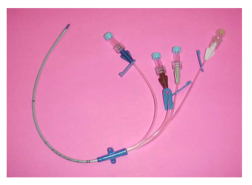Central venous line insertion
Introduction
A central venous line is a tube that is placed into one of the major blood vessels leading to your heart. The line is placed in your neck.
It is used for giving treatment directly into a vein for a short period of time—such as chemotherapy, antibiotics, food supplements, blood transfusions or for taking samples of your blood for testing.
Risks and benefits
The benefit of this procedure is that it will give you emergency medications for your condition. It is a very safe and quick procedure. The central line is a short-term line should last the course of your treatment.
It is common to get a small bruise around the wound site.
Very occasionally the bruise might be large which carries a risk of getting infected and would require treatment with antibiotics.
Very rarely, some damage can be caused to the vein which may need treatment by surgery.
There is a very small risk of developing breathing problems or bleeding from the procedure. There is also a risk that the line can become infected. This is reduced by personal hygiene and proper care of your central line by the medical and nursing staff.
There is also a small possibility that the line can fall out or that the line will become blocked. If this happens it will need to be replaced.
We will discuss all the risks and benefits in detail with you before your procedure.
Day of your appointment
Please do not eat or drink for 6 hours before your procedure. Please take all your medications as usual and, if you are diabetic, you may take your regular insulin. Blood thinning medications will be stopped by the nurse on the ward as necessary.
Before the procedure
On the ward your nurse will ask you several questions about your health and current medication. Your blood pressure and pulse will also be checked. You will be asked to change into a gown. Your nurse will bring you to the X-ray department on your bed.
In the X-ray department you will be seen by a doctor who will discuss the procedure with you before you give your consent. Please ask any questions you may have as it is important that you understand what is going to happen.
During the procedure
In the procedure room you will lie on an X-ray bed. Your neck will be cleaned with antiseptic fluid and you will be covered with a sterile drape. The doctor will give you an injection of local anaesthetic to numb the skin in your neck just by your collarbone and on your chest. This will cause some stinging initially and then go numb.
The procedure should not cause you any pain. Throughout the procedure a nurse will be with you who will monitor you. Please let the nurse know if you feel any discomfort.
The central line will be placed into a large vein in your neck. The doctor will put stitches in your skin to hold the central line in place and a large waterproof dressing will be placed over the line.
The procedure usually takes 30–60 minutes but may take longer.
After the procedure
After the line has been placed, you will go for a chest X-ray to make sure it is in the right position. You will go back to the ward where you will need to rest in bed for an hour. Your ward nurse will monitor you regularly. The central line will be ready to use. If you feel unwell or are in any discomfort at any time, please tell your nurse.
On the ward
Please contact your ward nurse immediately if you are experiencing any of the following:
- The skin around the line becoming red or inflamed, or if there is any swelling
- Leakage from the site
- Pain at the site
- Fever and chills
- Movement of the line

Contact information
Chelsea and Westminster Hospital
Interventional Radiology Department
1st Floor, Lift Bank D
T: 020 3315 8570/8582

